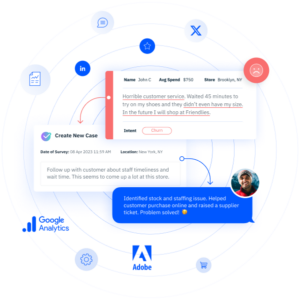How to Maximise Efficiency With a Small CX Team
Our experts have weighed in on the best ways to foster efficiency within your organisation and free up your time so that you can be left to focus on creating positive change and lasting impacts across the business.
Limited resourcing continues to be a challenge for customer experience (CX) teams across Australia and New Zealand. Whilst customer experience teams are becoming smaller, the remit of these teams are becoming broader and more complex. Most CX professionals in this region are expected to do more with less.
Our experts have weighed in on the best ways to foster efficiency within your organisation and free up your time so that you can be left to focus on creating positive change and lasting impacts across the business.
Here’s how you can maximise efficiency with a small customer experience team:
- Democratise Data
- Leverage available resources
- Create CX champions
- Level-up Your Dashboards
Democratise Data
Democratising data is an important step for protecting your teams’ time and resources, and it can be performed at any stage of CX maturity!
Invest the time needed with key stakeholders to explain the importance of customer experience, co-create dashboards, and reduce any ambiguity about CX programs. By spreading the responsibility between team members throughout your business, you will save time both now and down the line with fewer emails, more empowered colleagues, and more visibility to your hard work.
Leverage Available Resources
Technology alone won’t help with demonstrating return on investment. The most effective programs have a strategic partner to help map the initial CX framework, discover those actionable insights and point out the cost savings along the way. In a recent interview, Keira Hazell, Voice of Customer Manager for Kayo Sports and Binge, said,
“Get a CX partner to be an extension of your team. Relying on our partners at InMoment (previously MaritzCX) has extended my impact and strengthened our business outputs. ”
You need a motivated team behind yours to design the roadmap of experience management success. Best practices show that the financial impact of the CX capability is outlined in the onboarding process, tested and controlled along the way, and measured and reported against quarterly.
Create CX Champions
Take time upfront to educate teammates on the importance of customer experience and ask for volunteers to champion such initiatives across various departments. The more stakeholders invested in a CX program, the more time practitioners will have to delegate responsibilities across a business.
See which people in your business are organically gravitating toward your CX program and formalise their role as a CX champion. Empower these individuals to access the CX data anytime, anyplace to drive action. Along these lines, Voice of Customer Programme Lead of the New Zealand Post Trish Roberts described that,
“Your CX champions will start talking about the program and make your work visible across the organisation. The more people I train up to talk about this, the more time I have to focus on the program rollout.”
Level-Up Your Dashboards
When your dashboards are intuitive and easy to understand, stakeholders can easily circulate them within their organisations. Roberts also described her best practice tip for top-of-the-line dashboards:
“Include a bit of information around each module in the platform so when users log in to their dashboard, they will be reminded and feel empowered to talk to the scores and represent the data accurately.”
In other words, an effective dashboard is designed to guide the user, not overload the user with data.
We recommend you follow this design structure where possible:
- Main KPI: Where are we? How has our performance changed over time?
- Main KPI & Main Segment: Who/what should we focus on?
- Sub KPIs: What is contributing to our core metric?
- High Level Text Analytics: What overall are our customers telling us?
- Verbatim: What are our customers actually saying about their experience?
- Deep Analysis: Splitting KPIs up by pre-pop data.
Wrapping Up
It’s not easy doing big work with a small team, but by implementing these tips we hope it makes your job a whole lot easier. Thank you to our CX Leaders from Kayo and New Zealand Post for sharing their program optimisation insights and best practices.
For more CX best practices just like this, be sure to read our new eBook “Evolving Your CX Program” for additional tips and insights.




